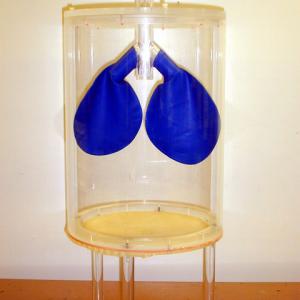College of Liberal Arts & Sciences
11A10.15 - Lung
Place new balloons on the "esophagus". Secure the top plate/lungs in place on the "body cavity" with nylon thumb screws. Place a new "diaphragm" onto the bottom opening and then attach the legs. DO NOT stretch the diaphragm tightly, but rather leave it loose enough so that you can easily grab it in the middle. As you then pull down on the diaphragm, the lungs should inflate (inhale). As you push up on the diaphragm the lungs should deflate (exhale).
- Gholamreza Shamsipour, "Simple Experiments for Teaching Air Pressure", TPT, Vol. 44, #9, Dec. 2006, p. 576.
- Ernie McFarland and Tom Kehn, "The Fantastic Physics Fun Show", TPT, #8, Vol. 34, Nov. 1996, p. 512.
- Praseto Listiaji et al., "Application of the Oscillation Concept: Measuring the Human Respiration Rate in Various Activities Using a Smarphone's Magnetometer Sensor", TPT, Vol. 61, #4, Apr. 2023, p. 304.
- V. J. Menon and D. C. Agrawal, "Physics of Quiet and Suffocative Breathing", AJP, Vol. 71, #5, May 2003, p. 474.
- Robert Sturm, "Inhaled Nanoparticles", PhysicsToday, Vol. 69, #5, May 2016, p. 70.
- Victor Zapana, "Made-to-Order Lungs", Popular Science, Vol. 282, #10, Oct. 2010, p. 30.
- "F-065. Bottle and Baggie", DICK and RAE Physics Demo Notebook.
- "Eureka! I'm 20% Fat!", Fluid Statics, Harvard Instructional Physics Labs, https://sites.fas.harvard.edu/~scphys/
- Charles Vivian, "Balloon in a Bottle", Science Experiments & Amusements For Children, p. 72.
- Janice VanCleave's, "Activity: Lung Model", The Human Body for Every Kid, p. 138 - 142.
- Christopher P. Jargodzki and Franklin Potter, "98. Open-Ended Toy Balloon", Mad About Physics, p. 34 - 35, 180 - 181.
- Joey Green, "Balloon in a Bottle", The Mad Scientist Handbook, Vol.1, p. 7 - 8.
- Martin Keen, "A Breathing Apparatus", Let's Experiment, 1968, p. 159 - 160.
- Sara Stein, "The Breathing Machine", The Science Book, p. 126.
- Julius Sumner Miller, Q164 & A164, Millergrams II – Some More Enchanting Questions for Enquiring Minds, p. 39 & 95.
Disclaimer: These demonstrations are provided only for illustrative use by persons affiliated with The University of Iowa and only under the direction of a trained instructor or physicist. The University of Iowa is not responsible for demonstrations performed by those using their own equipment or who choose to use this reference material for their own purpose. The demonstrations included here are within the public domain and can be found in materials contained in libraries, bookstores, and through electronic sources. Performing all or any portion of any of these demonstrations, with or without revisions not depicted here entails inherent risks. These risks include, without limitation, bodily injury (and possibly death), including risks to health that may be temporary or permanent and that may exacerbate a pre-existing medical condition; and property loss or damage. Anyone performing any part of these demonstrations, even with revisions, knowingly and voluntarily assumes all risks associated with them.
